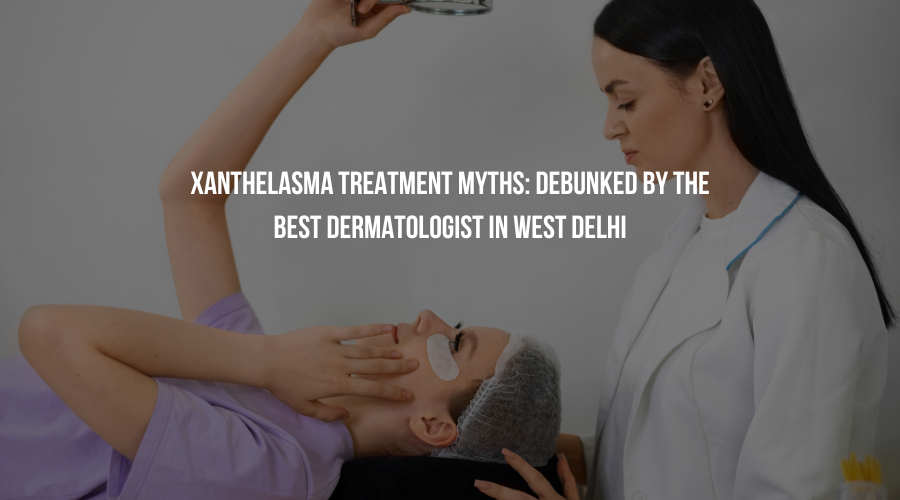
Xanthelasma is a common skin condition characterized by yellowish patches that generally develop around the eyelids. While these lesions are generally harmless, their appearance can be concerning for many individuals. Unfortunately, there are many myths surrounding Xanthelasma and its treatment, leading to misconceptions about how it can be managed effectively. In this blog, we’ll debunk some of the most prevalent myths about Xanthelasma treatment, providing insights from the best dermatologist in West Delhi.
Myth 1: Xanthelasma is Only a Cosmetic Issue
One of the most prevalent myths is that Xanthelasma is purely a cosmetic issue. While it’s true that these yellowish lesions can affect one’s appearance, they can also be indicative of underlying health conditions, particularly elevated cholesterol levels. In fact, Xanthelasma can serve as a warning sign for potential cardiovascular issues. Therefore, it’s essential to consult a skin specialist in Janakpuri or the best dermatologist in Delhi for a thorough evaluation and necessary tests. Understanding the causes behind it can help you in determining the appropriate treatment.
Myth 2: Xanthelasma Can Be Treated with Home Remedies
Many people believe that home remedies such as apple cider vinegar, garlic, or baking soda can effectively treat Xanthelasma. While these natural remedies may have their benefits for other skin conditions, they are not scientifically proven to eliminate Xanthelasma. Relying on these treatments can lead to delays in seeking proper medical care. Instead, consult a skin doctor in Delhi who can provide evidence-based treatment options tailored to your condition.
Myth 3: All Dermatologists Can Treat Xanthelasma Effectively
While many dermatologists are qualified to address various skin conditions, not all possess the same level of expertise in treating Xanthelasma. It’s crucial to seek treatment from a skin specialist in Janakpuri or the best dermatologist in West Delhi who has specific experience with this condition. A dermatologist with extensive experience in managing Xanthelasma can provide more effective treatment options and better results.
Myth 4: Surgery is the Only Option for Xanthelasma Removal
Another common misconception is that surgical removal is the only effective treatment for Xanthelasma. While surgical excision can be an option, there are various treatment methods available. Depending on the size and location of the lesions, a dermatologist in Janakpuri Delhi may recommend other approaches, such as:
Laser Treatment
This involves using focused light to break down the fatty deposits, leading to their gradual disappearance. Laser treatment is minimally invasive and can result in minimal scarring.
Cryotherapy
This technique involves freezing the Xanthelasma with liquid nitrogen, causing the lesions to eventually fall off.
Chemical Peels
Certain chemical solutions can help to exfoliate the skin and diminish the appearance of Xanthelasma over time.
By consulting with a qualified dermatologist, you can explore the best treatment option suited to your needs.
Myth 5: Xanthelasma Always Comes Back After Treatment
Many individuals fear that once they have undergone treatment for Xanthelasma, the lesions will inevitably return. While it’s true that some patients may experience recurrence, this is not a universal outcome. The likelihood of Xanthelasma returning often depends on underlying factors, such as genetics and cholesterol levels. A reputable skin specialist in Delhi will not only focus on the immediate treatment but will also work with you to manage any underlying conditions that could lead to recurrence. Regular follow-up appointments and lifestyle changes can significantly reduce the risk of reappearance.
Myth 6: Xanthelasma is Contagious
Some people mistakenly believe that Xanthelasma can spread through contact with an affected individual. This is entirely false. Xanthelasma is not a contagious condition; rather, it results from the accumulation of cholesterol deposits within the skin. If you have a family history of Xanthelasma, you may be more prone to developing it, but it is not something that can be passed on to others.
Myth 7: You Can Ignore Xanthelasma if You Don’t Mind the Appearance
While many individuals may choose to ignore Xanthelasma for cosmetic reasons, it’s essential to recognize that these lesions may signal potential health issues. A best dermatologist in Delhi will evaluate your skin condition and recommend necessary lifestyle changes or medical interventions. Early detection and treatment can help prevent complications associated with high cholesterol levels and associated cardiovascular risks.
Conclusion
Understanding the facts about Xanthelasma treatment is crucial for effectively managing this condition. By debunking these common myths, we hope to encourage people to seek professional advice from a qualified dermatologist in Janakpuri like Dr. Suruchi Puri. If you are dealing with Xanthelasma, don’t hesitate to consult a dermatologist in Janakpuri or the best dermatologist in West Delhi to receive personalized treatment options tailored to your needs.
Remember, skincare is an important part of your overall health. Whether through surgery, laser treatment, or other methods, effective solutions are available to help you manage Xanthelasma and improve your skin health.
